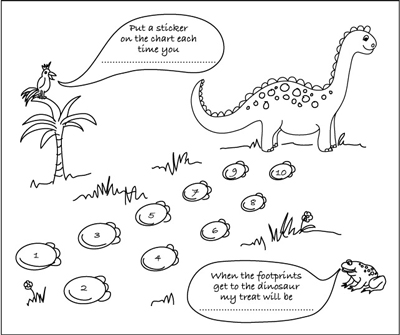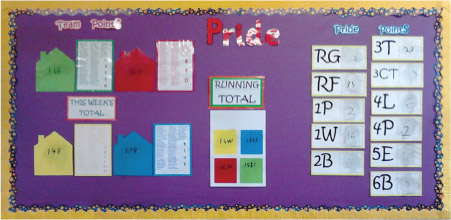2.2 Managing behaviour through reward charts
One way in which positive behaviour is encouraged, particularly with younger children, is through the use of reward charts. Some kind of system of sanctions and rewards is commonly used in secondary schools, although they may not use reward charts that focus on the individual, instead focusing more on group reward.
The article in the box below is a brief overview of the reward system, which we’d like you to read before doing the next activity.
Box _unit4.2.1 Reward charts and behaviourism
The use of reward charts or similar reward systems is common, particularly with young children, not only at home but also in schools and by social workers working with children who have particular emotional or behavioural needs. The theory behind such methods stems from a branch of psychology called ‘behaviourism’.
During the past 30 years, behaviourism has had many forms but in simple terms it is based on the idea that children’s (and adults’) behaviour can be changed through learning and association. If a child associates certain behaviour with bad outcomes, they will avoid it. If they associate it with good outcomes, they will repeat it.
‘Punishments’ might include having adult attention temporarily withdrawn or being excluded from group activities for a short while, sometimes referred to as ‘time out’. ‘Rewards’ are focused on more than ‘punishments’, particularly with younger children, and rewards are used to encourage desired behaviour and discourage undesirable behaviour.
There has been increasing criticism of behavioural strategies with children, primarily on the basis that, if they work at all, the benefits or changes in behaviour are short-lived. Criticism has also been made due to the fact that often one person (the adult) is manipulating or coercing the behaviour of another, the child.
However, where the child is involved in discussions about behaviour, this interaction between parent and child may in itself eventually bring about a positive change. A reduction in family tension can result when parents’ focus is redirected towards encouraging positive achievements rather than getting cross.
Different forms of reward charts or reward systems
These can take different forms and have different names. They may be aimed at individuals, such as through a traffic light system, or at the whole class, such as through a pride point system that earns a whole class reward. However they are ‘packaged’, they all involve children having to ‘earn’ something they desire, such as ‘golden time’ or a sticker.
Although reward charts may not be used within secondary schools, it is common to have a system of sanctions and rewards (Department for Education (DfE), 2012). In some schools children earn merit points, which they then log online and save up to earn prizes that range from basic things like stationery to something bigger like cinema tickets.
Some secondary schools take the reward away from being a personal reward. Children may log points that they earn but each point is worth an amount – maybe 1p. At the end of the year or term, the points are converted to cash and the money goes to the school’s charity of the year.
Losing a privilege or an opportunity can be used as a ‘stick’ to achieve desired behaviour by punishing unwanted behaviour.
Are reward charts and ‘time out’ the end of the story?
While professionals (and parents) sometimes find strategies such as reward charts and ‘time out’ effective in managing some behaviour with some children, the benefits are generally limited and short-lived and may do long-term damage to an individual’s self-motivation (Kohn, 1999).
Very often it is difficult to enforce the chart, and children may need to be coaxed into doing whatever was agreed to gain the sticker, or another tangible item showing progress towards the goal. As time goes on the child may become bored and disappointed that they are not achieving the reward they were working towards.
Sometimes reward systems do not work because the child does not want to be singled out as different in some way from their peers. In addition, some older children may not log their points because the prizes are given out in assembly and some children think they are ‘too cool’ or are embarrassed by the attention, however positive.
Activity _unit4.2.2 Activity 5
Having read the article on reward charts, now think about the following points:
- Do you think reward charts promote positive behaviour?
- What are the difficulties with using reward charts?
- If you use reward charts as a system for rewarding desired behaviour are there any changes you might suggest having read this article?
- If you don’t use reward charts, could they have a place in your school or setting?
Make some notes before reading our comments.
Discussion
Your answers to the bullet points will be individual. Your personal experiences and your own views on how behaviour should be managed will impact on your reflections around the effectiveness of reward charts, and whether they could have a place in your setting.
In thinking about the difficulties with using reward charts, you might want to refer back to Dreikurs’s goals of misbehaviour in Table 1 and Kyle’s behaviour (Activity 3). Consider whether – if Kyle is trying to gain attention by doing something that he knows is not allowed (i.e. using his phone in lessons) – he should be allowed to experience the logical consequences of his behaviour. One issue to think about is whether this is appropriate when the logical consequences of Kyle’s behaviour may have a negative impact on his education and future employment opportunities. How might self-motivation be achieved?


